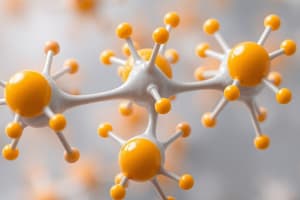Podcast
Questions and Answers
What is a possible CNS manifestation of atropine and atropine substitutes?
What is a possible CNS manifestation of atropine and atropine substitutes?
- CNS depression
- Convulsions (correct)
- Tachycardia
- Urinary retention
What symptom is common in infants and young children due to atropine and atropine substitutes?
What symptom is common in infants and young children due to atropine and atropine substitutes?
- Tachycardia and cardiac arrhythmias
- Constipation and urinary retention
- Mydriasis, cycloplegia and diplopia
- Dry skin, dry mouth, dry throat, dry eye and flushing of skin (correct)
What is a possible eye-related side effect of atropine and atropine substitutes?
What is a possible eye-related side effect of atropine and atropine substitutes?
- Cataract
- Dry eye
- Glaucoma
- Mydriasis, cycloplegia and diplopia (correct)
What is a possible cardiovascular side effect of atropine and atropine substitutes?
What is a possible cardiovascular side effect of atropine and atropine substitutes?
What is a possible gastrointestinal side effect of atropine and atropine substitutes?
What is a possible gastrointestinal side effect of atropine and atropine substitutes?
Which of the following is a contraindication for antimuscarinics, especially in certain cases?
Which of the following is a contraindication for antimuscarinics, especially in certain cases?
Which of the following conditions is a relative contraindication for antimuscarinics?
Which of the following conditions is a relative contraindication for antimuscarinics?
Which age group is more susceptible to the toxic effects of antimuscarinics?
Which age group is more susceptible to the toxic effects of antimuscarinics?
Which of the following is NOT a contraindication for antimuscarinics?
Which of the following is NOT a contraindication for antimuscarinics?
What is a condition in which antimuscarinics should be used with caution?
What is a condition in which antimuscarinics should be used with caution?
Flashcards are hidden until you start studying



